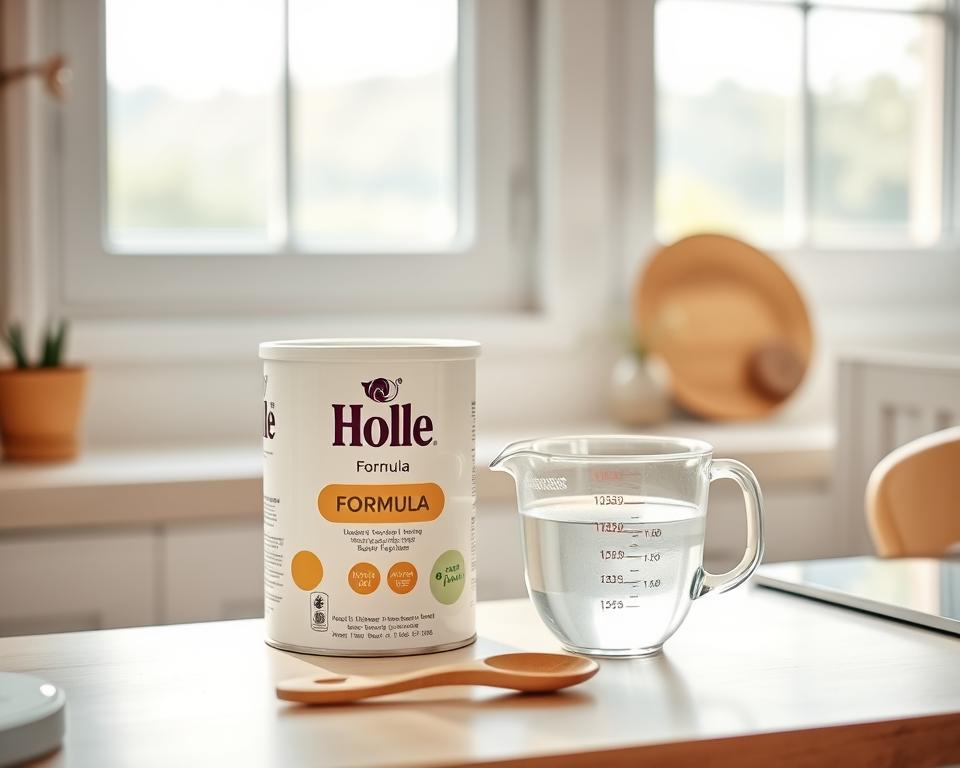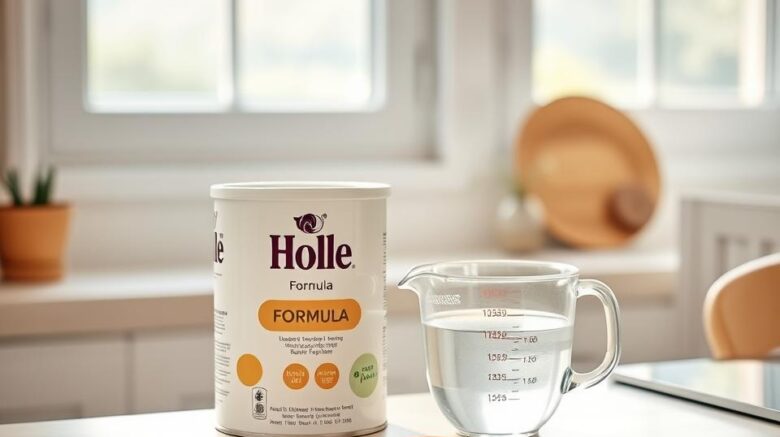Holle Formula Instructions: A Blending Guide
Have you heard almost 80% of caregivers face challenges in preparing infant formula properly? It might be intimidating, ensuring your baby gets the proper nutrients. Holle baby formula instructions serve to guide. Known for organic and premium ingredients, Holle formula instructions offers a comprehensive mixing guide.
This article is a crucial resource, offering clear Holle formula instructions. It makes certain you prepare formula accurately, protecting your baby’s health. You will find out the value of accurate measurements for peak nutrition. Plus, guidelines come in both English and German for your ease.
Understanding Holle Baby Formula
The Holle baby formula is celebrated for its organic and biodynamic farming practices. These approaches guarantee high-quality ingredients that target your baby’s health. With caregivers progressively concerned of preservatives in conventional formulas, Holle shines. It provides clean and natural nutrition, differentiating it.
What Makes Holle Formula Unique?
Holle’s uniqueness arises from its sourced ingredients, originating on sustainable farms. Each formula Stage is crafted to suit your baby’s developmental needs, without superfluous additives. This provides your child’s well-being, supplying nutrients for vibrant growth and development.
Types of Holle Baby Formula Stages
Holle delivers a range of formula Stages for various age groups, ensuring the proper nutrition as your child grows. Knowing these Stages guides you choose the best product for your baby:
| Holle Formula Stage | Age Group | Key Features |
|---|---|---|
| Stage Pre | From birth | Ideal for newborns, extremely digestible. |
| Stage 1 | From birth | Complete nutrition for infants, includes lactose. |
| Stage 2 | For 6–10 months | Boosted nutrients for weaning. |
| Stage 3 | For over 10 months | Rich in energy and vital nutrients for toddlers. |
Formula Preparation Guidelines
Feeding your baby necessitates knowing the importance of exact mixing. Holle formula instructions offer clear guidelines for ensuring your baby gets the correct nutrients. The correct mixing ratio is vital to your child’s health and nutrition.

Importance of Exact Mixing
Precise mixing is critical for a balanced diet in your baby. By sticking to Holle formula instructions, you can sidestep issues like underfeeding or overfeeding. An incorrect ratio can cause nutritional deficiencies or digestive problems. Aim for 1 scoop of formula powder to 1 ounce of water for the optimum consistency.
Adhering to precise measurements is a cornerstone of safe feeding practices. Each step in the mixing process is essential. Adhering to Holle instructions can significantly enhance your baby’s digestion and overall health.
Formula Preparation Steps
Securing your baby’s health and safety begins with correct Holle formula preparation. Use these easy steps to prepare Holle formula efficiently.
Step 1: Boil and Cool the Water
Initially, boil clean water. Let it settle 122°F (50°C). This temperature is safe for your baby, reducing the risk of harmful bacteria. It’s essential to do this for each serving to ensure safety.
Step 2: Measure and Mix the Formula
Start by adding half of the tempered water to a sterilized bottle. Add the correct scoops of Holle formula powder, using one scoop for every ounce of water. Close the cap and shake until the powder is thoroughly dissolved. Then, add the remaining cooled water, shake well, and check the temperature. It should be around 98°F (37°C) before feeding your baby.
Step-by-Step Holle Formula Instructions
Securing your baby’s health and nutrition is key. Properly mixing Holle formula based on age is vital. As newborns grow, their formula needs change. It’s crucial to adjust to these needs to prevent mistakes that could damage their health.
Age-Specific Ratios
Understanding the correct mixing ratios for your baby’s age is essential. In the first week, follow your pediatrician’s advice on water amounts and bottle frequency. As your baby grows, so do their formula needs:
| Age | Water (ml) | Formula Powder (scoops) | Bottles per Day |
|---|---|---|---|
| 0–1 Month | 90 | 3 | 6–7 |
| 1–2 Months | 120 | 4 | 5–6 |
| 2–4 Months | 150 | 5 | 5 |
| 4–6 Months | 180 | 6 | 4–5 |
How to Dodge Typical Errors
When preparing Holle formula, avoiding common mistakes is crucial. These include:
- Inadequately mixing the formula thoroughly, which can lead to clumps.
- Using water that is too hot, affecting both the formula’s quality and your baby’s safety.
- Ignoring recommended mixing ratios based on age, possibly impacting dietary intake.
By focusing on these details, you can provide a nutritious and well-mixed bottle for your baby.
Top Preparation Practices
Ensuring a safe and nutritious feeding experience for your baby involves following certain best practices for Holle formula preparation. These guidelines not only help preserve the quality of the formula but also safeguard your baby’s health.
How to Store Opened Powder
After opening a package of Holle formula powder, consume it within two–three weeks for peak freshness. To promote effective Holle formula storage, keep the formula in a cool, arid place, away from heat and humidity. This helps preserve its nutritional value and avoid spoilage.
Ensuring Safe Feeding Temperatures
Before feeding your baby, always do temperature checks to ensure the formula is around 98°F (37°C). This temperature is ideal for preventing burns to your baby’s mouth. Regular checks of both the formula’s integrity and the storage conditions are essential best practices for Holle formula preparation to maintain your baby’s health.
| Storage Condition | Duration | Recommended Action |
|---|---|---|
| Opened Powder | 2–3 weeks | Use within the recommended time frame |
| Mixed Formula | 1 hour | Discard any leftovers |
| Temperature for Feeding | Ideally 98°F (37°C) | Check before feeding to avoid burns |
Feeding Advice
Mastering the use of Holle formula is essential to a healthy feeding routine for your baby. It’s vital to adhere to recommended feeding amounts by age to ensure your baby gets the proper nutrition at each stage. Paying attention to hunger and fullness cues can make feeding more pleasant and deepen your bond.
Recommended Feeding Amounts by Age
Feeding amounts change as your baby grows. At about 2 months, babies typically need 4 oz (120 ml) of formula per feeding. As they get older, their needs increase, as shown below:
| Age (Months) | Feeding Amount (oz) |
|---|---|
| 1–2 | 4–5 |
| 3–4 | 6–7 |
| 5–6 | 7–8 |
| 7–12 | 8–10 |
Recognizing Baby Cues
It’s crucial to recognize hunger cues in babies to create a responsive feeding routine. Look for signs like:
- Rooting
- Lip-smacking, indicating readiness to eat.
- Fidgeting or crying when it is time to feed.
On the other hand, fullness signs include:
- Turning away the bottle or breast.
- Reducing sucking or falling asleep during feeding.
Noticing these signs promotes your baby’s healthy growth and builds a nurturing feeding relationship.
Time-Saving Tricks
On-the-go caregivers often seek ways to conserve time while ensuring their baby’s needs are met. Quick preparation of Holle formula is key in a fast-paced world. Quick mixing techniques can greatly streamline your formula preparation, allowing for timely feedings without sacrificing quality.
Speedy Preparation Methods
Portioning and mixing the right amounts of filtered water and formula powder in advance is a savvy strategy. Storing this mixture makes warming it up quicker when it’s time to feed your baby. You can heat it using a bottle warmer for consistent temperature or by placing the bottle under running water.
Another ingenious tip is to invest in a formula dispenser. This tool lets you pre-measure scoops of formula, making feeding on the go easy. Having everything ready to pour can revolutionize the process, ensuring the efficient preparation of Holle formula fits seamlessly into your everyday routine.
| Technique | Benefit |
|---|---|
| Pre-mix and refrigerate | Saves time during feedings |
| Use a bottle warmer | Ensures even temperature |
| Invest in a formula dispenser | Quick measuring for on-the-go feeding |
By using these quick mixing techniques, your preparation process becomes faster and more efficient. This benefits both you and your baby during feeding times.
Benefits of Using Holle Organic Formula
Opting for Holle organic formula brings numerous benefits that prioritize your baby’s health and nutrition. Holle guarantees only organic ingredients are used, providing a meal devoid of pesticides and synthetic additives. This commitment to organic farming results in a product that is both nutritious and designed for optimal growth. Parents can rest assured they are feeding their children with healthy, natural options that reflect their values.
Nutritional Advantages
The health advantages of using Holle organic formula for babies are notable. This formula is rich in essential nutrients, including DHA, which is crucial for brain development and cognitive function. The vitamins and minerals in Holle organic formula also support the immune system, providing a strong base for combating illnesses.
- Natural ingredients: Holle’s focus on organic farming ensures your baby gets food that is both nutritious and pure.
- Nutrients for growth: It contains vital vitamins that support physical and mental development.
- Stronger immunity: It helps building a stronger immune response against common illnesses.
By selecting Holle organic formula, you opt for a path that prioritizes your baby’s well-being. This provides peace of mind, knowing every feeding contributes to their healthy development.
Where to Buy
Looking for where to purchase Holle formula? Online retailers and organic baby food shops are your best bet. They offer a wide selection of Holle products, suited for meet your baby’s nutritional needs. This simplifies finding the perfect formula for your little one.
It’s essential to purchase Holle baby formula from reputable sources. This ensures the product’s authenticity and freshness. Reputable retailers offer detailed product information and often have customer support available to help. This boosts your confidence in choosing the best for your baby.
Many vendors also offer quick shipping, ensuring your order arrives promptly. Choosing reliable vendors to buy Holle baby formula streamlines your experience. It lets you focus on what’s most important—caring for your baby.
FAQ
How do you mix for Holle baby formula?
To prepare Holle baby formula, mix 1 scoop (or tablespoon) of powder with 1 ounce of water. This guarantees your baby gets the right nutrition.
How do you prepare Holle formula securely?
Start by boiling water and cooling it to 122°F (50°C). Then, measure half into a sterilized bottle. Add the right amount of formula powder, followed by the remaining water. Shake thoroughly and check the temperature before serving.
How many weeks is opened Holle formula powder?
Opened Holle formula powder should be used within 2 to 3 weeks for best freshness. Store it in a cool, dry place, away from heat and humidity.
Importance of precise mixing of Holle formula crucial?
Precise mixing is key to avoid underfeeding or overfeeding, which can damage your baby’s health. Keeping the water-to-powder ratio right is essential for balanced nutrition.
Common errors when mixing Holle formula?
Mistakes include not shaking the formula well to dissolve the powder and using water that’s too hot. This can cause clumps and uneven nutrition.
At what temperature must Holle formula be before feeding?
Serve Holle formula at about 98°F (37°C) to prevent burns to your baby’s mouth.
How can I ensure I’m using the right feeding amounts for my baby?
Feeding amounts depend on your baby’s age. For instance, a 2-month-old might need about 4 oz (120 ml) per feeding. Always check with your pediatrician for specific advice based on your baby’s growth and needs.
Where to buy Holle organic formula?
You can buy Holle organic formula online from authorized retailers and organic baby food shops. Make sure to purchase from trusted sources for authenticity and freshness.
What are time-saving tips for efficient formula preparation for busy parents?
Yes! Portion and mix the water and formula powder in advance, then refrigerate. This makes quick heating easier. A formula dispenser can also make feeding on the go simpler.
